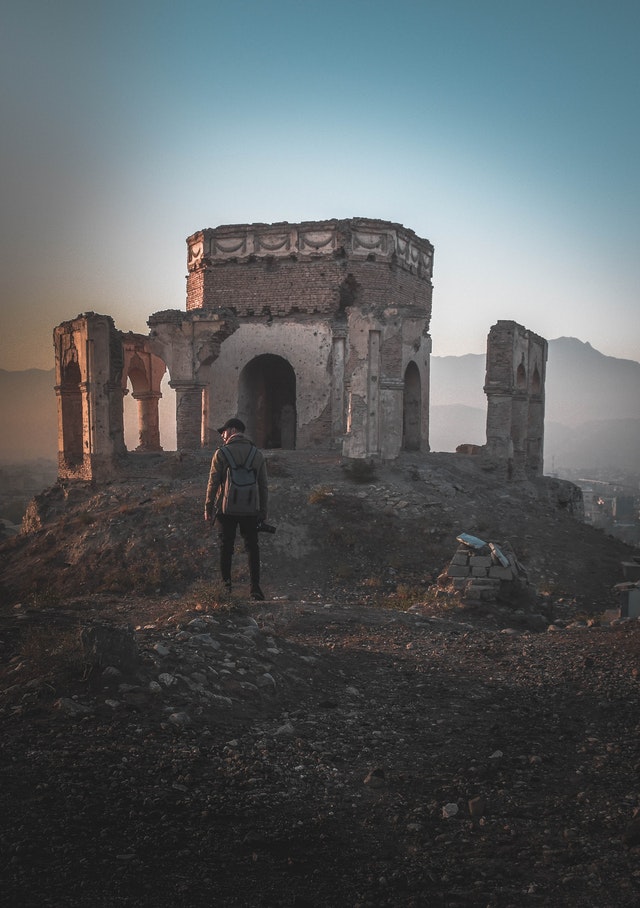The Precursor's Tower, Nyuknatsh (ɲəkˈnatʃ)
The Precursor's Tower at Nyuknatsh is a place of deep antiquity, still heavy with the magic that formed and sustained it. Like the other towers, I find it to be a sobering place and, as I work, I am oppressed by an awareness of my own insignificance within the stream of time. Though the structure of the tower and strength of the magic left in the surviving ruins suggest that the culture who built them had a level of arcane prowess unparalleled in the modern world, no record exists of the name of the city or its inhabitants (nor, I suppose, could we read it if we did find one). Even this colossal effort was not sufficient to keep them from oblivion.On the Aylarian-Choriris border, equidistant between the two countries' capitals, lies the ruin of a once-great citadel.
Architecture
The walls of the citadel enclose an octagonal area of 116,000 square metres. In the mathematical centre of the walls lie the remains of a fortified circular tower with a footprint of 20,000 square metres. Within the fortress, the footprint of houses and workshops remain visible as little more than low ridges in the landscape, organised around the ruin of a central tower.
The interior the tower was divided into floors, and parts of the first floor can still be seen at the top of the walls. Despite the enormous scale of the city, the size of internal doorways indicate that at least some inabitants would have been no taller than a yutaaq.
The ground floor of the tower is divided into a ring of antechambers arranged around a central atrium. In the centre of the atrium is a throne of carved basalt which would have once displayed a statue, approximates twenty metres tall, of a seated figure. Little remains of this sculpture but the feet and legs. In 5.895, a plaster copy of the sculpture that incorporated basalt debris found in the atrium was assembled by researchers from Chuiarancaca, but the head and chest of the figure are completely missing.
Althogh the interior of the building was not subject to the same intensity of protective enchantment, they have been protected from the wind and rain, and an antechamber unearthed in 5.897 was found to be decorated with a frieze showing an array of heavily stylised animals and plants unknown in the modern world. It is unclear if these were drawn from observation or if they represent imaginary beasts.
The style of the carving influenced the Monumentalist movement of 5.899-5.903.
Defenses
Walls
Now less than two metres at the highest point, the walls were made of a continuous piece of pink granite, three metres thick and buried to a depth of two metres. Despite the age of the stone, veins of magic are still visible during the fullest moon. The wall has been damaged in several places in a manner suggestive of military action, with a large breach on the southwest wall. Boulders of granite can be found inside the wall and around the site.Tower
The walls of the tower are two metres thick and butressed. There are no window or arrow slits in the remaining walls. Arclines in the interior walls show that the intrinsic defensive enchantments could be further bolsterd by magic users inside the structure, with additional arclines leading to and from upper floors. Consistent with the walls, the tower shows signs of massive damage from arcane sources, with sections of the granite showing evidence of having become molten and resolidified.History
Cracks from geologic activity and glacial erosion indicate that the site dates back to at least the Second Age. More accurate dating is made impossible due to the lack of comparable sites and the strength of the protective enchantments on the fortifications.
No human remains have been found in the area, nor tools nor jewellery. There is no evidence of the culture that built it or any subsequent people who may have lived there, and the city would have been a ruin when proto Ilca-Nawatli migrants crossed the land bridge to settle Xohura.
It is not the only Second Age ruin to have been found - five others are now known to exist - but it was the first, and the site has suffered extensively from the reuse of the stone to build the early fortifications of Chuiarancaca and Karayocsaka.
RUINED STRUCTURE
Unknown
Unknown
Remove these ads. Join the Worldbuilders Guild




Comments